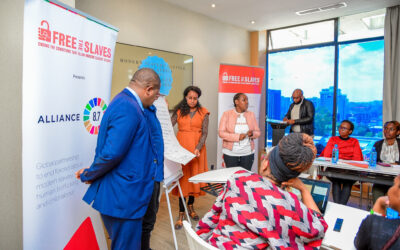Today’s globalized garment industry is characterized by fast fashion powered by modern-day slave labor. Garments go from seed to store via complex chains of transactions among independent parties that keep brands ignorant and unaccountable for labor abuses in factories. Brands are behind the times in technology to manage their supply chains.
Free the Slaves spoke with a technology expert who helps brands implement digital protection systems to track counterfeit goods. Zara Zamani discusses the potential of blockchain to become a tool to make complex supply chains transparent to both brands and consumers.
Zara Zamani: The internal systems within the brands are quite weak, they do not have strong internal communication systems or brand protection systems. If you look at brands, even quite famous brands, are still using emails or excel sheets to communicate with manufacturers and manage inventory. The reason is, they don’t want to see the other dimensions of their supply chain. All of this can be fixed with willpower from the brand. With blockchain you can track the price, how was it developed and what route the product took to reach the end user. When you are able to track and trace your product by having a cryptographic seal you can trace this from even before it goes to manufacturing from textile to end user.
Free the Slaves: Can you explain blockchain to someone who is new to it?
Zara Zamani: Blockchain is basically a distributed electronic ledger of transactions. You can see everything in real time, all the transactions there is no delay in accessing information. It is transparent, safe and less corruptible.
Even simple products can have complex supply chains. For example, the publication Apparel Business outlines the supply chain of a simple T-shirt:
- Step 1 is planting and harvesting the raw materials. Someone has to plant, cultivate, harvest and gin the cotton.
- Step 2 is weaving the fiber into cloth. Workers run the raw cotton fiber through a carding machine, then feed the yard into a loom.
- Step 3 is the purification and finishing. Someone singes, scours and mercerizes the cloth to purify it. Next, someone finishes the product by applying dyes or chemical finishing.
- Step 4 is where workers cut the finished cloth and sew pieces together to create garments.
- Step 5 is shipping finished products to the distribution warehouse where they can be sold to multiple stores.
Finally, your T-shirt makes its way to you, and all you see is on the tag is “Made in Bangladesh.” The people harvesting raw materials, weaving the fabric, finishing the cloth and sewing the shirt can experience forced labor, debt servitude, prison labor and human trafficking. Some may be children.
As the garment moves along the production chain from organization to organization there are contracts between companies, but the linkages to the finished brand get complicated. Companies often argue that it is difficult to trace all these factories. In response, California and a handful of countries have enacted legislation to force companies to be transparent about their supply chains.
Free the Slaves: Right now, brands are in transparency phase. In our world we always talk about transparency leading to accountability, do you think that as these regulations coming out for brands that blockchain is a chance for them to better comply with the modern-day slavery acts that are coming out?
Zara Zamani: It would take courage to pilot something like this. Whether you really want to make a change. You have to know that slave owners make $150 billion a year. We have to have the courage to go and fight against that. When you adopt blockchain technology you have to change a lot of your structure. You have to digitize a lot of your processes. A lot of processes that are not done manually but digitally. So, adopting blockchain is not a straightforward line. It has a lot of branches and all of them have to be connected for blockchain to work. That’s why if a company wants to adopt blockchain they have to get digitally transformed. It’s also changing a mindset, culture and soul to a digital organization.
Free the Slaves: Are there any apparel companies that are close to ready to this digital transition? Who is most ready to pilot blockchain in their supply chain?
Zara Zamani: I’m not sure if I can name them. But I can say that Germany is the most advanced. German government came up with the first regulation for blockchain in February 2019. They are very good in educating, in funding businesses and adopting blockchain. They have so many organizations that have started adopting it. The government is really supportive of them adopting it.
Free the Slaves: We represent NGOs on the Global Coordinating Group of the U.N. initiative to eradicate modern slavery, Alliance 8.7. One objective of the alliance is: “Governments, workers’ and employers’ organizations and other public, private and civil society organizations collaborate to enhance innovative processes such as financing models.” We have the Code 8.7 conference to bring together the artificial intelligence, machine learning, computational science and anti-slavery community together to address alliance objectives. Should the blockchain community be invited?
Zara Zamani: Yes. I would hope that an innovative business model for fighting against slavery. A new business model must be adopted when the system is digitized with blockchain. These tech communities should support each other. AI can validate whether blockchain is working, in the sense it can analyze the before and after to see if employing blockchain helped the situation.
With blockchain, instead of a garment tag saying “Made in India,” it might give you the whole story by saying “Made in the Ahmedabad-based Nandan Denim factory.” Companies can even make their blockchain public to allow consumers to go online and see every transaction that took place before the T-shirt reached the store.
Blockchain has the potential to answer a key question being posed by the ethical fashion movement: “Do you know who made your clothes?”



